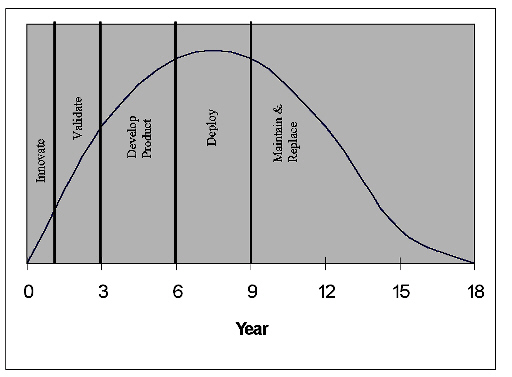 Exploitation
issues
Exploitation
issues Exploitation
issues
Exploitation
issues
View from
research
Researchers
are encouraged to ensure their work is relevant to industrial
needs. However, to achieve industrial impact, relevance alone is
insufficient. There must be mechanisms by which leading adopters
in industry can become aware of academic results, evaluate them,
and eventually adopt them in commercially viable products and
services. In addition, there must be mechanisms by which the
benefits of these new approaches and their adoption are diffused
through the rest of industry, both within and across sectors.
Of the research projects in the Systems Integration Initiative we ask that there should be a realistic route to significant eventual exploitation. This is not to say that there should be a product launched on the market immediately following a project. What is sought is real impact of the results on the issues, the participants and the wider community. The results should not be confined to research papers and just a little 'in house' exploitation in some of the industrial partners.
Exploitation of short-term research is not, in general, a problem. It is generally clear that the results are either to provide awareness for industry, with clear exploitation mechanisms, or the results inform further research.
Exploitation of long-term research is not, at first sight, a problem, in that exploitation is not an issue 'yet'. However, there is a gap. Industry has expressed concern about their perception of academe as having a shorter-term 'vision' than industry. But when academe does grapple with problems which require long-term research, even when visionary industrialists initially express enthusiasm, they are subject to the almost chaotic dynamics of business today. So it can be difficult to maintain continuity of specific industrial interest. 'Medium-term' was intended to mean 1-2 years, to contrast with the typical 3-year project with exploitation in the region of 5-10 years in the future. However, with regard to exploitation, it can equally be applied to more conventional 3-year projects which have potentially more immediately applicable results. It is this timeframe for research and potential exploitation which is most problematic.
Apart from the differences in time-to-market of research results, research projects vary considerably in nature. There is no single simple model of exploitation appropriate to all types of research.
It is much more difficult to achieve impact when the research results lead to an understanding of how to do things differently - simplistically, when the innovation is in a process rather than a product. If the output of research is of this kind, then serious large-scale commercialisation must be considered, else even the collaborating organisations are likely to drift away from using the results, as they are influenced by what is available in the market.
To compound the difficulty of introducing new ways of working, the processes of an organisation are usually interlocking with both other internal processes and processes of customers and suppliers. If research results imply a change of one or more processes, then how is that to be brought about?
Exploitation of research, leading to new ways of working may be difficult enough, but research into organisational structures and strategies can only be realised through new ways of thinking. Often this entails changes in organisational culture, which is known to be difficult. How can we rapidly diffuse new ways of thinking throughout industry in the face of such barriers to implementation?
It is not, in general, reasonable to expect academe to take on the exploitation. There is a growing willingness on the part of universities to undertake commercialisation, but this route is not generally as credible as exploitation by an appropriate established company. The simple view is that it is a role of industrial collaborators in a project to exploit the results. Maybe. Collaborators are not all of the same type. Often they will be 'problem owners' to provide case studies which form the basis of research and analysis and validation of new approaches.
View from
Industry
Within
large industry, there is a mismatch between the opportunities for
technical exploitation of research results and the commercial
opportunities. Before the results can be implemented a business
case needs to be established to justify the return on investment.
The timeframe for doing this does not match the completion of the
research project.

Within OEMs (Original Equipment Manufacturers), opportunities for technical exploitation of research results tend to be tied in within with the product life cycle. Ways of working tend to be set in concrete early within the conceptualisation phase. It is then not easy to change part way through a project. Therefore, opportunities for implementing major research results also tend to be early in the product life cycle. Obviously, there are more opportunities for implementing these results where the product life cycle is shorter. Where the product life cycle is much longer, with more complex processes and products, then the opportunities are limited by affordability. For the future, these opportunities need to be planned into the contract and the initial bid proposal processes.
Particularly when considering extended and virtual organisations, the impact of new technologies must respect the investment in information from previous years. Hence information standards are seen to play a key role in the future, enabling businesses to be flexible and reactive whilst protecting the knowledge / capability base.
Within SMEs, opportunities for exploitation are much higher and sometimes implementation is undertaken without due regard to all the consequences. They rely on 'affordable' or cheap consultancy, which, within the area of Systems Integration, lacks the experience and cannot impart the necessary confidence that the business will be sustained.
The problem for Government is that it cannot maximise its return on its investment in research nor cannot it ensure wide deployment across many industrial sectors.
'Problem-owners' are often called 'users', since they are potential users of any new technologies or techniques, which embody the research results. They are not usually suppliers of the products or services, which embody the results. So while they may indeed exploit 'in-house', they are not in general going to achieve industry-wide impact. One approach might be to include, as a collaborator, a 'supplier' of the appropriate products or services. But the more speculative the research, the more difficult it is to engage such companies and to maintain their involvement and certainly to obtain any commitment from them to market exploitation. Nevertheless, there have been some examples of successful collaboration and eventual exploitation of this kind, particularly where the 'suppliers' are manufacturers of physical products or developers of software.
However, where the realisation of results is not via products, but through new ways of working or thinking, then the appropriate form of 'supplier' is likely to be a supplier of consultancy services - possibly in association with new products, such as software tools. Indeed, consultancy might be used to gain greater gearing on any kind of research exploitation.
While there are some examples of participation by consulting firms in DTI and EPSRC-supported projects, there is scope for considering ways to enhance the coupling between the research community and consultants. (See “The potential role of Consultants in exploiting EPSRC funded research: Discussion ideas” February 2001, by Prof. Mike Hobday, SPRU). Like vendors, consultancies have only a limited span of companies they can affect. How might even greater gearing be achieved? Television? Videos distributed through Business Links? Could they be reached through their supply chains? Trade Associations? Again, though, researchers do not normally use these channels. Nor do consultancies. So who does? Typically, DTI awareness activities. Perhaps there is scope for greater interaction between researchers, consultancies, intermediaries, EPSRC and DTI, with support from industry, to research these issues in the first instance, and then to establish appropriate mechanisms aimed at getting greater yield from academic research.